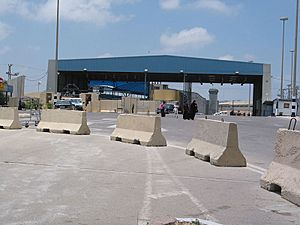Israel–Gaza barrier facts for kids
The Gaza–Israel barrier is a special fence and wall system. It is built on the Israeli side of the border with the Gaza Strip. This barrier helps Israel control who and what goes in and out of Gaza.
There are two main crossing points along this barrier. The Erez Crossing in the north is mostly for people and some goods coming from Israel. The Kerem Shalom border crossing is in the east. It is used for goods coming from Egypt. Israel requires all goods entering Gaza to pass through Israel, even if they come from Egypt.
Israel first built a fence here in 1994 to help with security. It has been rebuilt and made stronger over the years. This barrier helps Israel manage the movement of people and items between Gaza and Israel.
There is also a crossing point on the border between Egypt and Gaza, called the Rafah Crossing. This crossing is mainly for people. However, Israel requires that most cargo or goods for Gaza must go through Israel, usually via the Kerem Shalom crossing.
Contents
Why the Barrier Was Built
In 1993, Israel and the Palestinian Liberation Organization (PLO) signed an agreement called the Oslo Accords. These agreements set up the Palestinian Authority. This group was given some control over parts of the West Bank and the Gaza Strip.
Even after these agreements, Israel still controls Gaza's airspace (the sky above Gaza), its land borders (except the one with Egypt), and its territorial waters (the sea near Gaza).
In 2005, Israel removed its soldiers and thousands of Israeli settlers from the Gaza Strip. After this, Israel said it had ended its occupation of Gaza. However, some people disagree. They say that because Israel still controls Gaza's borders, airspace, and sea, it still has a lot of power over Gaza. People in Gaza also do not have Israeli passports.
How the Barrier Is Built
Israel started building the first barrier along its border with the Gaza Strip in 1994. This first part was about 60 kilometers (37 miles) long. An agreement from 1994 stated that this fence would stay in place. It also said the fence line was only for the purpose of that agreement. This means the fence itself does not always mark the exact border. The first barrier was finished in 1996.
Before 2005, Israeli soldiers kept a special empty area, called a buffer zone, inside Gaza. This zone was about one kilometer (0.6 miles) wide along the border. It stopped people from getting too close to the border. After Israel's soldiers left Gaza in 2005, it became easier for Palestinians to reach the border.
So, Israel started building a much stronger security system along the Gaza border. This new system was very expensive, costing about $220 million. It was planned to be finished by mid-2006.
The new barrier includes a 7-meter (23-foot) high wall. It has sensors, remote-control machine guns, and barbed wire in areas close to Israeli towns. The land used for this barrier was taken from nearby farms, and the farmers were paid for it.
The first barrier was a simple barbed-wire fence with no sensors. The second barrier, called Hoovers A, is about 20 meters (66 feet) away. It has a road and a fence with sensors. These parts existed before 2005. A newer part is a wide empty area, 70 to 150 meters (230 to 490 feet) wide, called Hoovers B. This area has motion sensors in the ground. It is surrounded by a new fence with sensors and watchtowers every 2 kilometers (1.2 miles). These watchtowers have remote-control machine guns instead of soldiers. This is because soldiers could be targets for snipers.
The barrier is watched from both the air and the ground.
Crossing Points for People and Goods
Since 2011, there are only two main crossing points between Israel and Gaza. The northern Erez Crossing is for people and some goods coming from Israel. The eastern Kerem Shalom border crossing is for goods coming from Egypt. Israel does not allow goods to go directly from Egypt into Gaza.
Some older crossing points, like the Sufa Crossing and Karni Crossing, were closed by Israel in 2008 and 2011.
For Palestinians, these crossing points are very important. They are vital for Gaza's economy and for people's daily needs. A Palestinian leader named Saeb Erekat said that closing these crossings has "proven to be counter-productive," meaning it causes more problems than it solves.
Erez Crossing
The Erez Crossing is a place where people and goods can enter Israel from northern Gaza. This crossing is usually only open to Arab residents who live under the Palestinian Authority. It is also open to people from Egypt or international aid workers. Tourists are usually not allowed to use this crossing.
Palestinians who have special permits can use Erez Crossing. These permits allow them to work in Israel, get free medical treatment, or visit family members in prison.
About 5,000 Palestinians are allowed to use the Erez Crossing to go to their jobs in Israel. However, Israeli authorities often close the crossing. This makes it hard for people to get to work. Sometimes, soldiers at the crossing have even taken away permits from people.
Kerem Shalom Crossing
The Kerem Shalom border crossing is located on the border between the Gaza Strip and Israel. It is managed by the Israel Airports Authority. This crossing is used by trucks carrying goods from Israel or Egypt into the Gaza Strip.
See also
- Egypt–Gaza barrier
- Israeli West Bank barrier
- Egypt–Gaza border
- 2018–2019 Gaza border protests
Images for kids
-
A Merkava tank patrols the Gaza border in February 2012.



